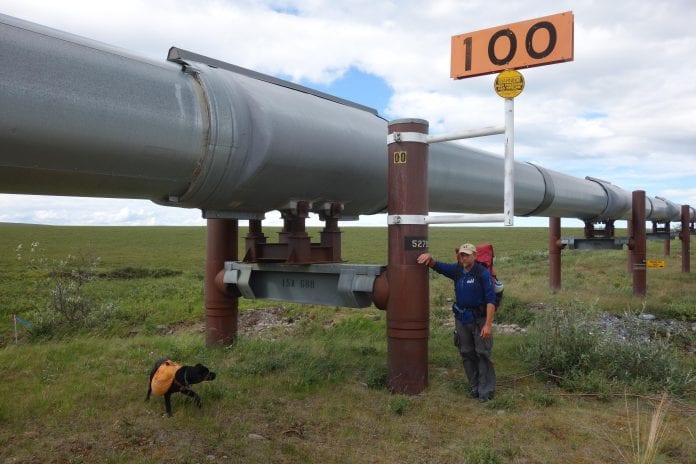
Public Employees for Environmental Responsibility has released federal documents describing how the federal Bureau of Land Management has reduced its Alaskan assets, leaving fewer qualified staff to review the structural integrity of the aging Trans-Alaska Pipeline System.
In a reorganization plan approved in mid-December, the BLM cut the number of cost reimbursable, full-time equivalent positions that support and are funded by the TAPS right of way operator, Alyeska Pipeline Service Co., PEER said Feb. 4. A total of 8.5 slots are eliminated and the Alyeska reimbursement for five remaining BLM staff will be reduced to one-half their full cost, said PEER.
The big issue for Cordova, says Rick Steiner, of Anchorage a retired University of Alaska marine conservation professor and PEER board member, is for a major pipeline spill that could send crude oil into the Copper River. “Many reasonable people think this is not the time to be deregulating oversight of the pipeline,” he said. The (changing) climate is changing the permafrost under some of the pipeline; “it has become a more complex engineering problem that needs more federal and state oversight, not less,” he said. “We have learned by hard experience never to trust Alyeska. Everyone in Prince William Sound knows that lesson.”
According to the organizational change approval document from the BLM’s Alaska State Office, “the ultimate goal of the reorganization is to provide streamlined management oversight that is more consistent with national policy and guidance for rights-of-way. With reduced BPM (Branch Pipeline Monitoring) staffing, it is not administratively efficient to maintain a branch-level structure.” Additional reductions in staff are anticipated through attrition, according to the BLM document.
“Our purview is the terminal (in Valdez) and the tankers,” said Brooke Taylor, director of external communications for the Prince William Sound Regional Citizens Advisory Council, but with the BLM restructuring, the PWSRCAC asked the BLM ex-officio member of the board for an update on the restructuring, she said. “It is something we are watching pretty closely. It is something we will be looking into and communicating on for the next few months at least.”
PEER cites related BLM documents, a history of TAPS corrosion problems, and a length 2004 report prepared by Fairbanks-based economics and environmental consultant Richard Fineberg for the Prince William Sound Regional Citizens Advisory Council on provisions for eventual dismantling and removal of TAPS facilities and restoration of the land utilized by those facilities.
Construction of the 800-mile crude oil pipeline with 11 pump stations, and several hundred miles of feeder pipelines, stretching from Alaska’s North Slope to the Valdez Marine Terminal, was completed in 1977. The pipeline is owned by a consortium of oil companies including BP, ExxonMobil, Conoco Phillips and Unocal Pipeline Co.
According to the BLM documents the stated rational for reduction of engineering staff to review the structural integrity of TAPS “has shifted from engineering review to more traditional management of rights-of-way.” The BLM decision document also states that “the change will have no impact to the public. No public outreach is necessary and will not be conducted.”
“This reorganization confers savings on the big oil companies that own the pipeline but not a penny for the taxpayer” said Steiner. “BLM’s decision to keep a reduction of public oversight over this gargantuan structure a secret from the public is disquieting, to say the least.
Steiner describes the current situation as “very dangerous from the standpoint of folks in Cordova. The pipeline crosses several streams that go right into the Copper River,” he said. “if you had a pipeline rupture in any of those streams, you would have oil going right into the Copper River. There would be absolutely nothing you could do about the oil flowing down the right,” he said.
PEER contends that scaling back BLM oversight is coming as TAPS is entering a precarious period, with aging, corrosion-plagued materials spread across hundreds of miles of harsh terrain. The pipeline now moves just a quarter of the volume that it carried at its peak. This reduced flow causes the crude oil to move slower, lose more heat and gum up the system in myriad ways, creating ever more complex and expensive engineering problems, PEER said. And with an end in sight, no steps have been taken to plan for the legally required dismantling and removal of TAPS facilities and restoration of the land utilized by pipeline facilities, according to PEER.
Michelle Egan, chief communications officer for Alyeska, responded that the pipeline company has experts on staff focusing on what is happening and changing in the TAPS right-of-way. “They monitor permafrost, slope stability, changing rivers and floodplains, temperature shifts, weather patterns, seismic activity,” Egan said. “And we work very closely with the university (of Alaska) on these same issues,” she said.
Alyeska has ongoing maintenance and inspection monitors at all facilities and the mainline, she said. “These activities are monitored and regulated. US DOT PHMSA (Pipeline Hazardous Materials Administration) is another agency that provides oversight and brings specific expertise in pipelines, she said.
“Alyeska has studied and addressed the issues associated with lower flow rates and has invested in numerous changes to the system to allow for lower volume. This includes the addition of heat, advanced pigging, advanced surveillance, pump station improvements. With our monitoring and engineering solutions, we are comfortable operating the system down to flow rates well below 500,000 bbls per day. What’s more, the decline has leveled off and the forecast is for this trend to continue” she said.
As for steps for the eventual dismantling and removal of TAPS, Egan cited Pump Station 10, which is already out of service. “Several years ago we ‘straight lined’ the flow through that station, reducing the risk associated with idle station piping, and we are in the midst of a project that includes removing facilities at PS 10,” she said.














